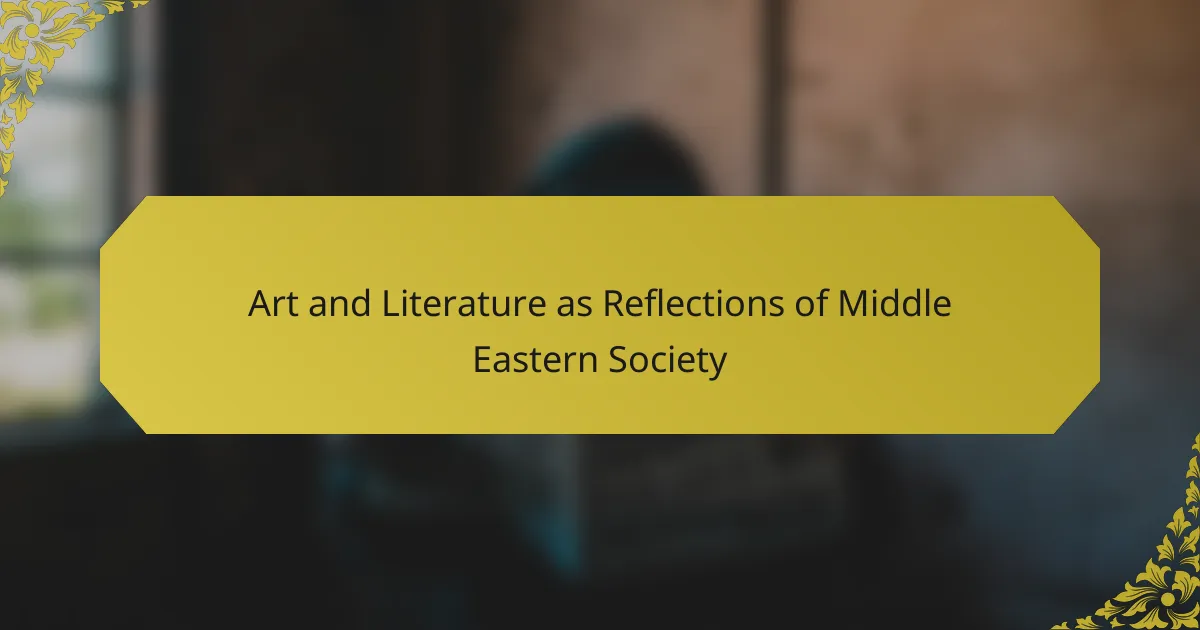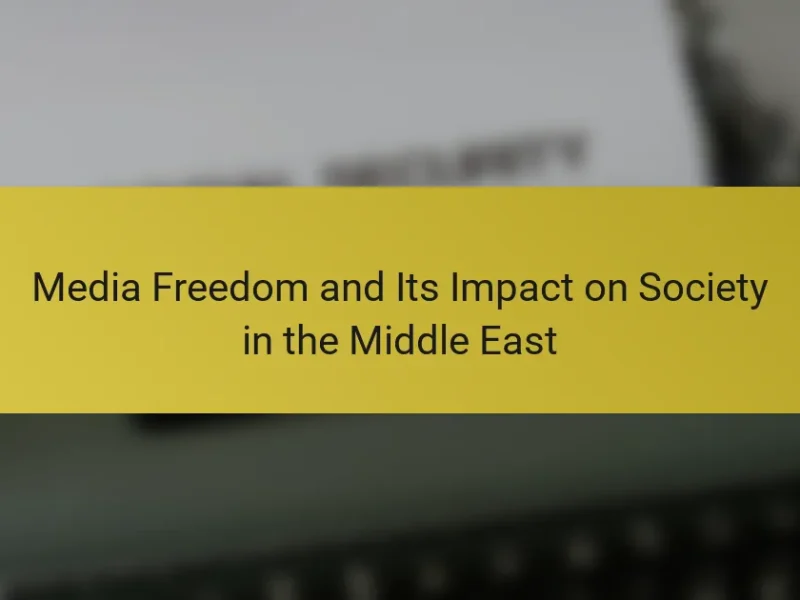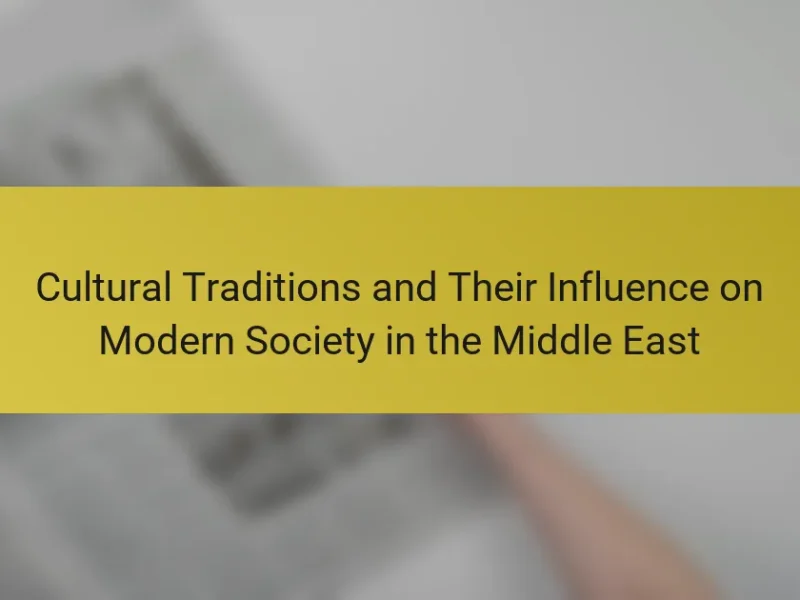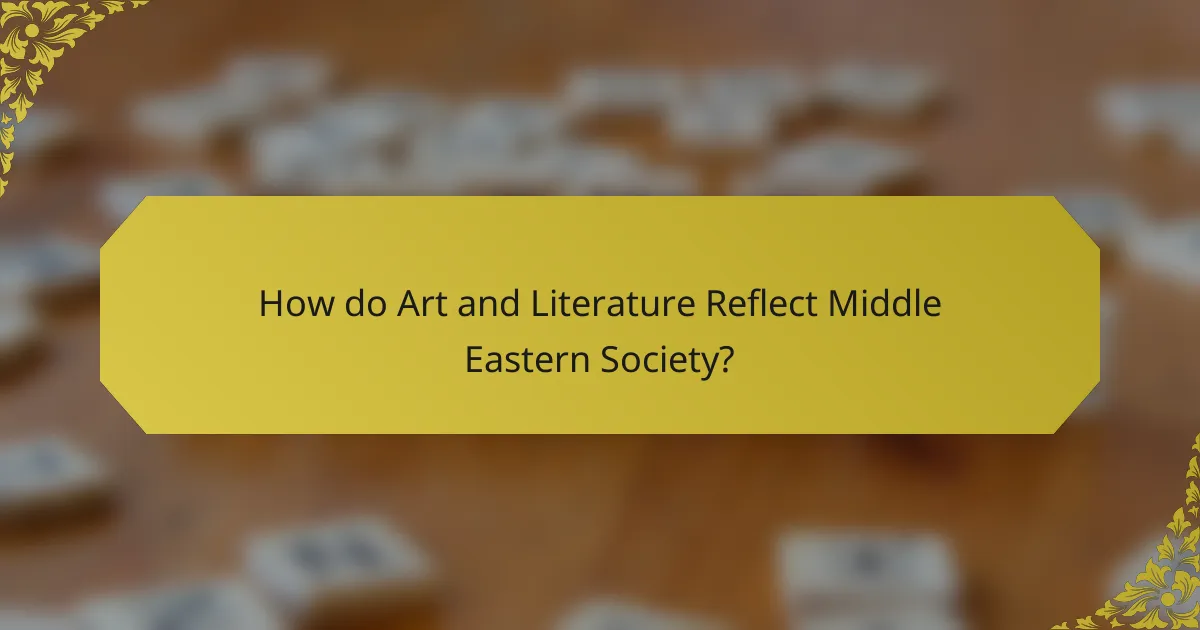
How do Art and Literature Reflect Middle Eastern Society?
Art and literature reflect Middle Eastern society by expressing cultural values, historical narratives, and social issues. They serve as mirrors of the region’s diverse identities. Traditional art forms, such as calligraphy and textile design, showcase the significance of religion and heritage. Contemporary literature often addresses themes like conflict, migration, and identity struggles. For instance, the works of authors like Khaled Hosseini highlight personal and collective experiences in times of turmoil. Additionally, visual art movements in the Middle East often respond to political changes and societal shifts. This interplay between creation and context illustrates the dynamic relationship between art, literature, and the fabric of Middle Eastern life.
What are the key themes present in Middle Eastern art and literature?
Key themes in Middle Eastern art and literature include identity, [censured], and social justice. Identity is often explored through cultural heritage and personal narratives. [censured] reflects the region’s diverse religious beliefs and practices. Social justice themes address issues like inequality and human rights. Historical context plays a significant role in shaping these themes. For instance, the impact of colonialism is frequently depicted in various works. Nature and landscape are also prevalent, symbolizing both beauty and struggle. These themes resonate with audiences, reflecting the complexities of Middle Eastern societies.
How do historical events shape these themes?
Historical events significantly influence themes in art and literature. They provide context and shape narratives that reflect societal values and struggles. For example, the Arab Spring inspired a surge in artistic expression addressing freedom and oppression. Similarly, the impact of colonialism is evident in literature that critiques power dynamics. The Iranian Revolution led to a rich body of work exploring identity and resistance. Events like wars and migrations also generate themes of loss and resilience. These historical contexts allow artists and writers to engage with their societies meaningfully. They create a dialogue between past experiences and contemporary issues, enriching the cultural landscape.
What cultural symbols are commonly depicted?
Cultural symbols commonly depicted in Middle Eastern art and literature include the crescent moon, stars, and calligraphy. The crescent moon and stars represent Islamic faith and are often featured in flags and architecture. Calligraphy serves as a revered art form, emphasizing the beauty of Arabic script. Additionally, motifs like geometric patterns and floral designs symbolize the region’s rich artistic heritage. These symbols reflect historical, religious, and cultural identities within Middle Eastern societies. For instance, the use of geometric patterns is rooted in Islamic art, which avoids depicting human figures.
In what ways do art and literature influence societal values?
Art and literature significantly influence societal values by shaping perceptions and beliefs. They reflect cultural norms and challenge existing ideologies. Through storytelling and visual representation, they evoke emotional responses. For example, novels can highlight social injustices, prompting discussions and advocacy for change. Historical art movements often mirror the political climate of their time. Literature can introduce new ideas, influencing public opinion and behavior. In the Middle East, works like Khaled Hosseini’s “The Kite Runner” reveal personal and societal struggles, fostering empathy. Overall, art and literature serve as catalysts for societal reflection and transformation.
How do they challenge or reinforce social norms?
Art and literature in Middle Eastern society both challenge and reinforce social norms. They often reflect the complexities of cultural identity and societal expectations. For example, contemporary literature may critique traditional gender roles, highlighting women’s struggles for autonomy. This can challenge the status quo and inspire social change. Conversely, certain art forms may celebrate cultural heritage and reinforce existing values. Traditional poetry and storytelling often uphold familial and communal ties, promoting social cohesion. Additionally, visual art can depict societal ideals, reinforcing norms around beauty and morality. Overall, these creative expressions serve as both mirrors and molders of societal values.
What role do they play in shaping identity?
Art and literature play a crucial role in shaping identity within Middle Eastern society. They serve as mediums for expressing cultural values and historical narratives. Through storytelling, art reflects the complexities of social issues and personal experiences. This reflection fosters a sense of belonging and community among individuals. Additionally, art and literature challenge stereotypes and promote understanding of diverse perspectives. They also contribute to the preservation of language and tradition, reinforcing cultural identity. Historical examples include the works of poets like Rumi and artists who depict societal struggles. Such expressions help individuals connect with their heritage and navigate contemporary challenges.
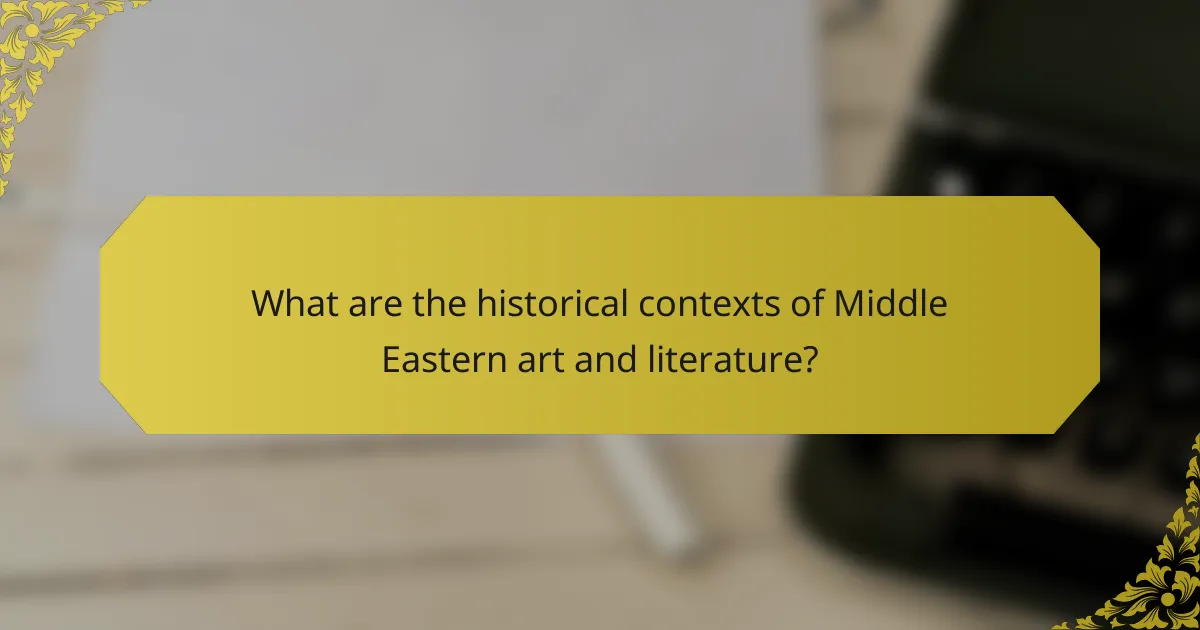
What are the historical contexts of Middle Eastern art and literature?
Middle Eastern art and literature have evolved through various historical contexts shaped by cultural, religious, and political influences. The rise of [censured] in the 7th century significantly impacted artistic expressions and literary forms. Islamic art often emphasizes geometric patterns and calligraphy, reflecting religious beliefs. The Golden Age of [censured] (8th to 14th centuries) fostered advancements in literature, science, and philosophy. Notable figures like Rumi and Al-Farabi emerged during this period, contributing to rich literary traditions.
Colonialism in the 19th and 20th centuries introduced Western influences, leading to a blend of traditional and modern styles. Nationalism and identity became central themes in literature during this time. Contemporary Middle Eastern art often addresses social and political issues, reflecting ongoing struggles and cultural identity. The historical contexts of Middle Eastern art and literature are thus interwoven with significant events and movements, shaping their evolution and expression.
How has the evolution of art forms mirrored societal changes?
The evolution of art forms has closely mirrored societal changes throughout history. As societies progressed, their values, beliefs, and experiences were reflected in artistic expressions. For example, the transition from traditional to modern art in the Middle East illustrates shifts in cultural identity and political landscapes. During the Ottoman Empire, art focused on religious themes and intricate patterns, representing a unified cultural identity. In contrast, contemporary Middle Eastern art often addresses social issues, such as war and displacement, showcasing the impact of conflict on society. The rise of street art in urban areas reflects a response to political unrest and a desire for social change. Additionally, literature has evolved from classical poetry to modern narratives that challenge societal norms. This progression highlights how art serves as a barometer for societal values and transformations, providing insight into the collective consciousness of a community.
What significant movements have influenced these art forms?
Modernism, post-colonialism, and feminism are significant movements that have influenced art and literature in the Middle East. Modernism introduced new styles and themes, challenging traditional forms. It emerged in the early 20th century, reflecting the societal changes in the region. Post-colonialism critiques the effects of colonialism on identity and culture. This movement gained prominence after the mid-20th century, as countries gained independence. Feminism has also played a critical role, addressing gender issues and advocating for women’s rights. This movement has been particularly influential since the 1970s, reshaping narratives in both art and literature. Each of these movements has contributed to the evolution of artistic expression and literary themes in Middle Eastern society.
How do traditional and contemporary styles interact?
Traditional and contemporary styles interact by blending historical techniques with modern expressions. This interaction creates a dialogue between past and present. Traditional styles often serve as a foundation for contemporary artists. They incorporate elements like motifs, patterns, and themes from historical art. Contemporary styles reinterpret these elements to address current societal issues. This fusion can be seen in various art forms, including painting, sculpture, and literature. For example, contemporary Middle Eastern literature frequently references traditional storytelling methods. This blend enriches the cultural narrative and preserves heritage while promoting innovation.
What role did colonialism play in shaping modern art and literature?
Colonialism significantly influenced modern art and literature by introducing new themes and perspectives. It often led to the fusion of indigenous and foreign artistic styles. This blending created unique expressions in various art forms and literary works. Colonial narratives frequently explored identity, resistance, and cultural hybridity. Artists and writers responded to colonial experiences, reflecting societal changes and struggles. For instance, the works of Edward Said highlighted the complexities of post-colonial identity. Moreover, colonialism prompted a reevaluation of traditional forms and subjects in art and literature. This resulted in the emergence of new genres and movements that challenged established norms. Overall, colonialism played a crucial role in shaping the evolution of modern art and literature.
How did colonial influences alter local artistic expressions?
Colonial influences significantly altered local artistic expressions in the Middle East. These influences introduced new styles and techniques from Europe. Artists began to incorporate Western themes and perspectives into their work. Traditional forms were often blended with European artistic methods. This resulted in a hybridization of art that reflected both local and colonial narratives. For instance, the introduction of oil painting changed the medium used by local artists. Additionally, colonial education systems promoted Western art appreciation, impacting local artistic training. The outcome was a transformation of cultural identity as artists navigated between tradition and colonial expectations.
What are the legacies of colonialism in contemporary works?
The legacies of colonialism in contemporary works include themes of identity, power dynamics, and cultural hybridity. Many contemporary artists and writers explore the impact of colonial histories on their societies. They often depict the struggles of post-colonial identities in their narratives. Works reflect tensions between traditional cultures and modern influences. Additionally, colonialism’s effects on language and storytelling are evident. Authors frequently use hybrid languages to express complex identities. Visual artists may incorporate colonial symbols to critique historical narratives. These legacies serve to challenge dominant cultural perspectives.
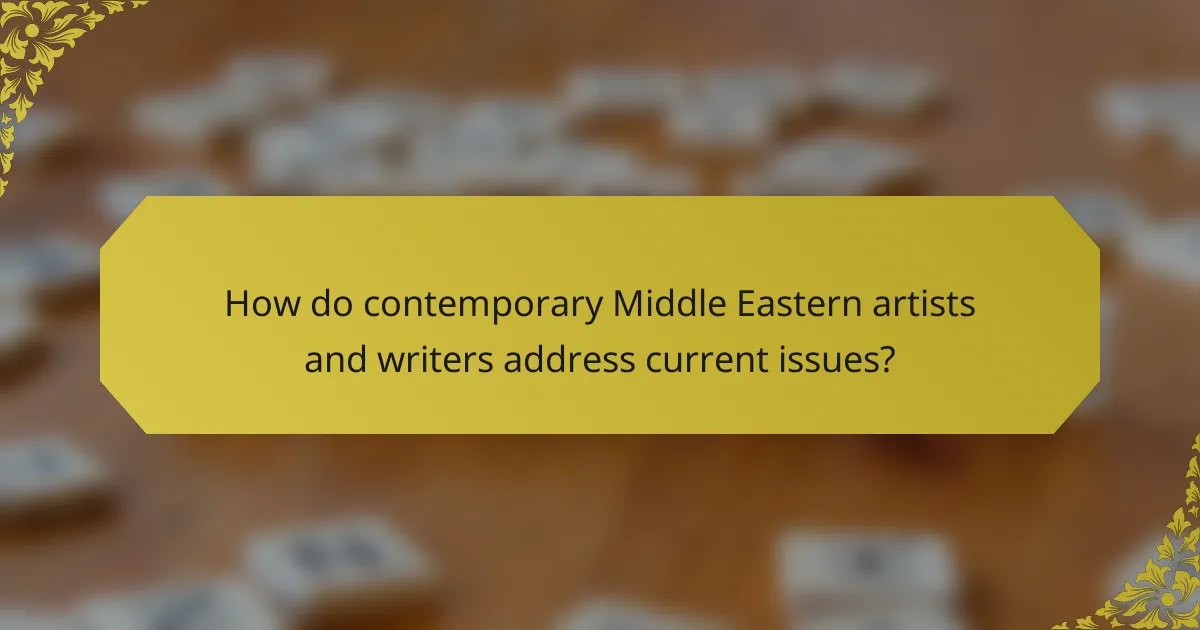
How do contemporary Middle Eastern artists and writers address current issues?
Contemporary Middle Eastern artists and writers address current issues through various forms of expression. They explore themes such as identity, conflict, and social justice. Many use their work to critique political regimes and highlight human rights violations. For instance, artists like Ai Weiwei have engaged with refugee crises in their installations. Writers such as Khaled Hosseini tackle themes of war and displacement in their novels. Visual art and literature often serve as platforms for activism. This engagement reflects the socio-political landscape of the region. Artists and writers aim to provoke dialogue and inspire change through their narratives.
What social issues are commonly explored in modern works?
Common social issues explored in modern works include gender inequality, political oppression, and economic disparity. Gender inequality manifests through the portrayal of women’s rights and roles in society. Political oppression is depicted in narratives focusing on authoritarian regimes and censorship. Economic disparity often highlights class struggles and the impact of globalization. Additionally, themes of migration and identity are prevalent, reflecting the experiences of displacement. These issues resonate deeply within the context of Middle Eastern society, influencing both literature and art.
How do artists and writers respond to political unrest?
Artists and writers respond to political unrest by creating works that reflect societal issues. They often use their art to comment on injustice and oppression. For example, many Middle Eastern poets and novelists address themes of conflict and resistance in their literature. Visual artists may depict scenes of protest or the impact of war in their paintings. These creative expressions serve to raise awareness and provoke thought. Historical examples include the works of Palestinian poet Mahmoud Darwish, who captured the struggles of his people. Similarly, Iranian filmmakers have portrayed the consequences of political repression in their narratives. This artistic response is crucial for documenting experiences and fostering dialogue within society.
What themes of migration and diaspora are prevalent?
Prevalent themes of migration and diaspora include identity, belonging, and cultural dislocation. These themes reflect the experiences of individuals and communities affected by migration. Identity often shifts as migrants navigate new cultural landscapes. Belonging is frequently challenged, leading to feelings of alienation. Cultural dislocation can result in the loss of traditions and language. Historical contexts, such as conflicts and economic opportunities, drive these migration narratives. Literature often portrays these themes through personal stories and collective experiences. Art serves as a medium to express the emotional and social impacts of diaspora.
How can art and literature be used as tools for social change?
Art and literature can be powerful tools for social change by raising awareness and inspiring action. They provide a platform for marginalized voices to express their experiences and challenges. For instance, novels like “The Kite Runner” by Khaled Hosseini highlight issues such as poverty and discrimination. Poetry can convey deep emotions and provoke thought on social injustices. Art installations can visualize societal problems, making them more relatable and urgent. Historical movements, such as the Harlem Renaissance, show how literature can unite communities for a common cause. Studies indicate that engaging with art can foster empathy and motivate individuals to participate in social movements. Thus, art and literature serve as catalysts for dialogue and transformation within society.
What movements have emerged from artistic expressions?
Various movements have emerged from artistic expressions in Middle Eastern society. These include Modernism, which sought to break away from traditional forms. Postcolonialism emerged as artists responded to colonial legacies. Feminism in art highlighted women’s voices and experiences. The Arab Spring inspired political art that addressed social change. Contemporary art movements reflect globalization and cultural exchange. Additionally, street art has become a significant form of expression in urban areas. Each movement reflects the cultural, political, and social dynamics of the region. These artistic expressions serve as a mirror to the evolving identity of Middle Eastern society.
How do collaborations between artists and activists manifest?
Collaborations between artists and activists manifest through joint projects that address social issues. These collaborations often combine artistic expression with advocacy efforts. For example, artists may create visual works that highlight human rights abuses. Activists can use these artworks to amplify their messages and reach wider audiences. Public installations and performances are common forms of these collaborations. They engage communities and provoke dialogue around critical topics. Historical instances include the use of art in protests during the Arab Spring. Such collaborations can lead to increased awareness and mobilization for change.
What practical insights can we gain from analyzing Middle Eastern art and literature?
Analyzing Middle Eastern art and literature provides insights into cultural identity and societal values. These forms of expression reflect historical contexts and contemporary issues. For instance, art often portrays themes of conflict, resilience, and community. Literature frequently addresses social justice, gender roles, and political dynamics.
Through these mediums, one can understand the impact of colonialism and globalization on regional identities. The works of authors like Naguib Mahfouz reveal the complexities of urban life in Cairo. Visual art from artists such as Shirin Neshat explores themes of gender and exile.
Additionally, analyzing these works fosters cross-cultural understanding. It highlights the diversity within Middle Eastern societies. This understanding can promote dialogue and empathy in a global context. Overall, Middle Eastern art and literature serve as vital windows into the region’s social fabric and evolving narratives.
Art and literature serve as critical reflections of Middle Eastern society, encapsulating cultural values, historical narratives, and social issues. Key themes such as identity, [censured], and social justice are explored through various artistic expressions, influenced by historical events like colonialism and political unrest. The interaction between traditional and contemporary styles highlights the evolution of these forms, while contemporary artists and writers address current issues, fostering dialogue and social change. Analyzing these works provides insights into the complexities of Middle Eastern identities and societal values, promoting cross-cultural understanding.
